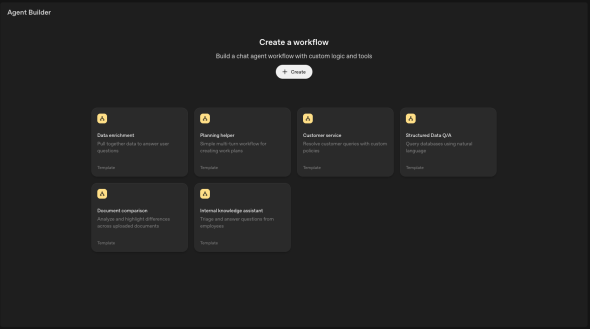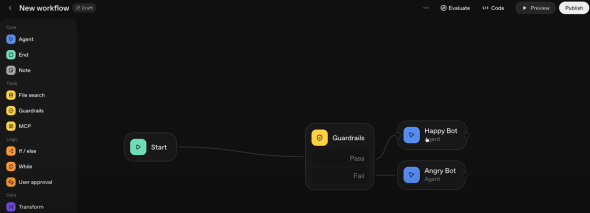OpenAI AgentKit: The Pro AI Agent Builder for Developers
OpenAI AgentKit is a software development toolkit that provides developers the components to build, deploy, and manage AI agents. Developed and launched by OpenAI in October 2025, the platform gives users an integrated, enterprise-focused method for creating autonomous agents that can reason, plan, and execute complex tasks.
This OpenAI AgentKit is designed to address the common difficulties of fragmented toolchains and manual orchestration that slow down AI development. It targets AI engineers and developers across various industries, from tech startups to large enterprises like Klarna and Canva.
The platform’s primary value is its ability to reduce development time and manage the entire agent lifecycle, from initial prototype to production-level deployment. It offers an alternative to traditional, often difficult methods of building AI assistants by offering an integrated environment with visual builders, pre-built connectors, and specific evaluation tools, making the process faster and more efficient.
Best Use Cases for OpenAI AgentKit
- Customer Support Automation: With this ai agent builder, support teams can construct agents to handle a high volume of customer inquiries. These agents can access knowledge bases to provide instant, factual answers, deflect common tickets, and escalate complex issues to human agents with full context. For example, an agent can handle two-thirds of all support conversations, as demonstrated by Klarna, freeing up human staff to focus on high-priority problems.
- Internal Operations & Knowledge Management: Companies can use OpenAI AgentKit to create internal assistants that help employees navigate complex processes and find information. An agent can connect to internal systems like SharePoint or Google Drive to answer questions about company policies, guide users through IT troubleshooting, or help analysts pull sales data. This centralizes knowledge and improves employee productivity.
- Sales & Marketing Automation: Sales teams can deploy OpenAI AgentKit to automate lead research and personalized outreach. An agent can analyze prospect data from various sources, generate tailored email drafts, and even score leads based on predefined criteria. This accelerates the sales cycle and allows representatives to focus on building relationships rather than on manual research.
- Data Analysis & Reporting: For business intelligence teams, this toolkit can build agents that automate data retrieval and report generation. A manager could ask an agent to “create a plan to improve sales in the Northwest region,” and the agent would analyze historical trends, seasonality, and external factors to produce a data-backed strategy, similar to the use case implemented by Albertsons.
Accelerated Development: The combination of a visual builder, SDKs, and pre-built components like ChatKit can reduce development cycles from months to weeks for new ai workflow automation.
Enterprise-Focused Tools: The OpenAI AgentKit is built for production use, offering specific features for versioning, governance, and security.
Detailed Evaluation Framework: The "Evals" feature provides specific tools for testing, grading, and improving agent performance, a critical component for reliable deployment.
Finished User Experience: ChatKit allows developers to embed a professional, customizable chat interface into any application with minimal front-end coding.
Unified Platform: It consolidates the entire agent development lifecycle into a single, cohesive environment, removing the need for fragmented third-party tools.
Developed by OpenAI: The toolkit is created and maintained by a leader in the AI industry, meaning it will likely remain current with agentic technology.
Strong Initial Use Cases: Notable clients like Klarna, Canva, and Ramp have already demonstrated significant ROI, proving the platform's real-world value.
Developer-Centric: The platform requires coding knowledge for effective use, making it less accessible for a no code ai agent builder user or business teams.
Potential for Vendor Lock-In: The OpenAI AgentKit is optimized for its own models, limiting flexibility for teams wanting to use other LLMs.
Unpredictable Pricing: The usage-based pricing model, while flexible, can make it difficult to forecast costs, which may be a concern for businesses with variable demand.
Learning Curve for Advanced Features: While the basics are straightforward, mastering the advanced orchestration and evaluation tools requires a significant time investment.
-
Agent Builder: A visual, drag-and-drop canvas for designing, versioning, and managing complex, multi-agent workflows.
-
ChatKit: A front-end toolkit for embedding customizable, chat-based agent experiences directly into websites and applications.
-
Connector Registry: A central location for managing secure connections to data sources and tools like Dropbox, Google Drive, and SharePoint.
-
Evals Framework: A system for measuring and improving agent performance through test pipelines, trace grading, and automated prompt adjustments.
-
Agents SDK: A software development kit available in Python, Node.js, and Go for programmatic control and deep integration.
-
Pre-built Templates: A library of ready-to-use templates for common use cases like customer support and internal knowledge bots.
-
Workflow Versioning: Allows teams to safely iterate on agent designs by managing multiple versions and rolling back changes when needed.
-
Built-in Guardrails: Enterprise-level controls to keep agents operating within predefined safety and compliance boundaries.
-
Multi-Agent Orchestration: Capabilities to design systems where multiple specialized agents collaborate to solve a single, complex problem.
-
Thread Management: ChatKit automatically handles the complexities of managing conversation histories and user sessions.
 AI Agent Builder
AI Agent Builder
 AI Automation Workflow
AI Automation Workflow
Frequently Asked Questions
-
What is OpenAI AgentKit?
OpenAI AgentKit is a toolkit for developers to build, deploy, and optimize AI agents for enterprise use. -
What is an ai agent builder?
An AI agent builder is a platform or set of tools that allows users to create, configure, and deploy autonomous AI agents that can perform tasks, make decisions, and interact with other systems. -
What is the best ai agent builder?
The best AI agent builder depends on the user’s needs. OpenAI AgentKit is a strong choice for developers needing an integrated, enterprise-level platform within the OpenAI system. Other tools like Sim are better for non-technical users seeking a no-code experience, while open-source options like n8n offer more flexibility and control for technical users. -
How do I learn ai workflow automation?
You can learn AI workflow automation by starting with no-code platforms like Zapier to understand the basics of triggers and actions. From there, you can progress to more advanced tools like n8n or OpenAI AgentKit. Learning the Python programming language is also highly beneficial, as it is the standard for AI development and is supported by most advanced agent-building frameworks. -
Who is the target audience for AgentKit?
The primary audience is AI engineers and software developers who need to build production-level autonomous agents. -
How is AgentKit priced?
The features are included with standard OpenAI API model pricing, following a usage-based cost model. -
What problem does the OpenAI AgentKit solve?
It addresses the difficulty of fragmented toolchains in AI agent development by providing a single, unified platform. -
What is ChatKit?
ChatKit is a feature within AgentKit that provides a toolkit for embedding a customizable chat UI into websites and apps.
Tech Pilot Verdict’s on OpenAI AgentKit
I’ve been watching the AI agent field develop, so I was interested to use the OpenAI AgentKit to see if it truly simplifies the path from prototype to production. My goal was to assess its core function: can a developer with moderate AI experience build a useful agent without getting bogged down in custom orchestration and front-end development?
To test this, I set out to build a common use case: an internal knowledge assistant. The mission of Agent Kit would be to answer employee questions by referencing internal policy documents. First, I used the Connector Registry to link to a sample folder in Google Drive. The process was direct and felt secure, with clear authentication steps. This centralized panel is a huge plus for governance, as you can see and manage all data connections in one place.
Next, I moved to the Agent Builder. The visual canvas is intuitive for mapping out simple workflows. I created a flow where the agent receives a user query, retrieves relevant information from the connected documents, and generates a response. For this simple task, the visual interface was sufficient. However, I can see how building a complex, multi-step agent with conditional logic would quickly require using the Python SDK for more control. This is where the “developer-centric” label becomes apparent. It’s low-code to start, but pro-code to master.
The most useful feature I found was ChatKit. I was able to embed a functional chat window into a simple webpage in under an hour. ChatKit handled all the difficult parts—streaming responses, managing conversation history, and displaying sources. This feature alone could save a team weeks of front-end development work.
However, the pricing model is a concern. The pay-as-you-go structure tied to API usage makes it hard to predict costs. An internal tool with a few hundred employees could see costs change depending on usage patterns. This is a significant consideration for any business looking to deploy agents at scale.
Top Alternatives to OpenAI AgentKit
-
n8n: This platform is an open-source ai workflow automation tool. It offers far more pre-built integrations than AgentKit, making it a good choice for automating tasks across a wide variety of non-AI applications. While you can integrate LLMs, n8n functions as a procedural automation tool, not an AI-native agent builder. If you are looking for an ai agent builder like n8n but with more agentic capabilities, AgentKit is the better fit. Choose n8n if your primary need is connecting hundreds of different apps and you want the flexibility of a model-agnostic, self-hostable program.
-
Sim: Sim is an open-source ai agent builder, Sim is a more direct competitor. Its main advantage is its user-friendly interface, making it accessible to non-technical users. Sim is purpose-built for creating AI agents and offers flexibility with over 100 connectable models and apps. This is a better choice for business teams or citizen developers who want to build AI automations without writing extensive code.
-
Zapier: As a leader in no-code automation, Zapier connects thousands of web apps with simple, trigger-action workflows called “Zaps.” Its main strength is its massive library of over 7,000 integrations and its ease of use for non-technical users. However, Zapier is not a tool for building reasoning agents; it automates linear, predefined tasks between apps. It is the best choice for business users who need to automate simple, repetitive workflows without writing any code.
Final Verdict on Agent Kit
After my review, it’s clear that the OpenAI AgentKit is a functional and well-designed platform that removes much of the difficulty of building AI agents. Agent Kit is a professional toolkit for developers. Its greatest strengths are its rapid development capabilities, finished UI components like ChatKit, and its evaluation tools.
If you are a developer or a team already using the OpenAI API and need to build and deploy production-level agents quickly, this ai agent builder is one of the most complete choices available.

